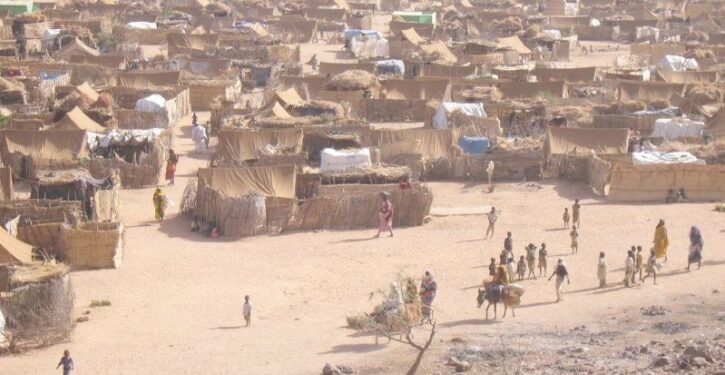
“For only the third time in the past 20 years, the UN has declared a full-blown famine,” reports The Economist. The declaration was in response to starvation at a huge refugee camp in Sudan called Zamzam, located on the outskirts of a provincial capital. Five months ago, a child died of starvation in that camp every two hours. Now, the death rate there is much higher than that:
But it is not just Zamzam that is suffering a horrifying catastrophe. The camp has been singled out solely because it is one of the few places in war-torn Sudan about which the UN has reliable information. In fact, famine is consuming much of the country..It is almost certain to be as bad as, or worse than, the one that afflicted Ethiopia in the 1980s [which killed 1.2 million people]. If much more help does not arrive very soon, it may prove the worst anywhere in the world since millions starved to death during China’s Great Leap Forward in the late 1950s and early 1960s.
In May the Clingendael Institute, a Dutch think-tank, released a report which estimated that hunger and related diseases would kill more than 2 million people in Sudan by the end of the year. Timmo Gaasbeek, the report’s author, has since extended his projections to cover the next two years. In an “optimistic scenario”, in which fighting stops and this year’s harvest, expected in October, is slightly better than the last, he predicts around 6 million “excess deaths” by 2027. In the (more likely) scenario in which fighting continues until early next year, more than 10 million may perish. Although some experts have lower estimates, there is an emerging consensus that without decisive action Sudan faces mass starvation on a scale not seen in decades….
The cause of the famine is Sudan’s civil war, which began in April 2023, when the army and an auxiliary paramilitary, the Rapid Support Forces (RSF), fell out. The ensuing conflict has a strong claim to be the biggest and most destructive in the world today. Perhaps 150,000 people have been killed by the fighting itself. At least 245 towns or villages have been burnt. Much of Khartoum, the capital, has been flattened. More than 20% of the country’s pre-war population of roughly 50 million have been forced to flee their homes. Some have taken refuge in neighboring countries such as Egypt, but the vast majority of the displaced—nearly 8 million—remain inside Sudan, many of them in camps like Zamzam.
Earlier, the water supply for the region containing one of Sudan’s largest cities (Port Sudan) was destroyed, when a dam collapsed, killing hundreds of people.
Sudan’s national museum was looted by the RSF, the rogue militia that controls most of Sudan’s populated areas. The museum housed “the world’s largest and most comprehensive Nubian archaeological collection, along with artifacts from other ancient civilizations including the Kingdom of Kush (8th-4th century BCE) and the medieval Kingdom of Alwa. The Nubian collection” included “embalmed mummies dating back to 2,500 BC, making them among the earliest and most important such examples in the world.” The museum also had some Christian relics from Sudan’s pre-Islamic period. Sudan, like Egypt, has pyramids and mummies.
The RSF interfered with harvests in Sudan’s Jazira state, which is “home to one of the largest irrigation systems in the world,” reported CNN. Thousands of farmers fled the RSF into areas controlled by Sudan’s military, leaving fields untended.
Tens of thousands of Sudanese have previously died of starvation during the war. Thousands of bodies were left decomposing in morgues in the country’s capital. At least 150,000 civilians were killed in fighting between Sudan’s warring factions.
Frankenstein’s monster turned on its creator, in Sudan. Over a decade ago, Sudan’s military created the Rapid Support Forces (RSF), a genocidal militia it used to wipe out villages inhabited by some African tribes in Sudan’s Darfur region. Now, this Frankenstein’s monster, the RSF, is fighting Sudan’s military in a civil war, and has taken over most of Sudan’s capital region, and its breadbasket region. It is slaughtering males from western Sudan’s black African Masalit tribe. It sexually enslaved some women, and raped others. The RSF committed mass killings and rapes to drive the Masalit ethnic group from Sudan into the neighboring country of Chad.



